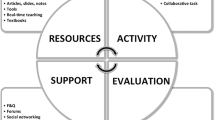Abstract
This study explores the effect of three distinct living-learning community models on a variety of student experience and academic performance outcomes. Central to the analysis is an investigation of whether there are differences in outcomes for learning communities with different missions and structures, all three of which fall into the “Linked Course” learning community design. Even in the least coordinated, most basic, learning community model, students show more positive outcomes (first semester GPA, retention, first-year experience) than nonlearning community students. The fact that simple structures that facilitate student interaction around academic work (even without coordinated faculty involvement) have a positive effect for students of all preparation levels provides encouragement to campus leaders with limited resources who are working to develop methods for improving the undergraduate educational experience on their campuses.
Similar content being viewed by others
REFERENCES
Astin, A. W. (1991). Assessment for Excellence, Jossey-Bass, San Francisco.
Astin, A. W. (1993). What Matters in College: Four Critical Years Revisited, American Council on Education/Macmillan, New York.
Cheseboro, J. N., Green, R. L., Mino, M., Snider, K. J. G., and Venable, A. M. (1999).Measuring learning community effectiveness: Conception, an instrument, and results.Paper presented at the American Association of Higher Education Assessment Forum, Denver, CO, June 1999.
Lenning, O. T., and Ebbers, L. H. (1999). The powerful potential of learning communities: Improving education for the future. ASHE-ERIC Higher Education Report, 26 (6), The George Washington University, Graduate School of Education and Human Development.
Lindblad, J. (Spring 2000). Learning community assessment studies: What the Washington Center resources show. Washington Center News.
Love, A. G. (1999). What are learning communities? In: Levine, J. H. (ed.), Learning Communities: New Structures, New Partnerships for Learning (Monograph No. 26), National Resource Center for the First Year Experience and Students in Transition, University of South Carolina, Columbia, pp. 1–8.
Love, A. G., and Tokuno, K. A. (1999). Learning community models. In: Levine, J. H. (ed.), Learning Communities: New Structures, New Partnerships for Learning (Monograph No. 26), National Resource Center for the First Year Experience and Students in Transition, University of South Carolina, Columbia, pp. 9–18.
MacGregor, J., Smith, B. L., Matthews, R. S., and Gebelnick, F. (n.d.). Learning community models. Washington Center for Improving the Quality of Undergraduate Education.
Matthews, R. S. (1994). Enriching teaching and learning through learning communities.In: O'Banion, T. (ed.), Teaching and Learning in the Community College, American Association of Community Colleges, Washington, DC, pp. 179–200.
Matthews, R. S., Smith, B. L., MacGregor, J., and Gebelnick, F. (1997). Creating learning communities. In: Graff, J., Ratcliff, J., and Associates (eds.), The Handbook of the Undergraduate Curriculum, Jossey-Bass, San Francisco, pp. 457–475.
Pascarella, E. T., and Terenzini, P. T. (1991). How College Affects Students, Jossey-Bass, San Francisco.
Smith, B. L. (2001). The challenge of learning communities as a growing national movement.Peer Rev. 3(4): 2–4.
Snider, K. J. G., and Venable, A. M. (May 2000). Assessing learning community effectiveness: A multi-campus approach. Presented at the Association for Institutional Research Annual Meeting, Cincinnati, OH.
Tinto, V. (1993). Leaving College: Rethinking the Causes and Cures of Student Attrition (2nd Ed.), The University of Chicago Press, Chicago.
Tinto, V. (1998). Colleges as communities: Taking research on student persistence seriously.Rev. Higher Educ. 21: 167–177.
Tinto, V. (2000). What have we learned about the impact of learning communities on students? Assessment Update, 12(2): 1–2, 12.
Tinto, V., Love, A. G., and Russo, P. (1994). Building Learning Communities for New College Students: A Summary of Research Findings of the Collaborative Learning Project, National Center for Postsecondary Teaching, Learning, and Assessment, University Park, PA.
Author information
Authors and Affiliations
Corresponding author
Rights and permissions
About this article
Cite this article
Stassen, M.L.A. Student Outcomes: The Impact of Varying Living-Learning Community Models. Research in Higher Education 44, 581–613 (2003). https://doi.org/10.1023/A:1025495309569
Issue Date:
DOI: https://doi.org/10.1023/A:1025495309569




